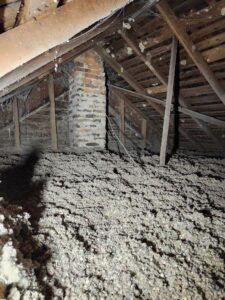Understanding Closed Cell Spray Foam Insulation
Closed cell spray foam insulation is a type of insulation that offers high R-value, meaning it provides excellent thermal resistance. It is made by mixing two components on-site and then sprayed into place, where it expands and hardens. This type of insulation forms an airtight seal, preventing air and moisture infiltration. Additionally, closed cell spray foam insulation has a high compressive strength, making it a good option for areas that require additional structural support.

Benefits of Closed Cell Spray Foam Insulation
Closed cell spray foam insulation offers several benefits over wet blown cellulose insulation. Some of the key advantages of closed cell spray foam insulation include:
- Superior thermal insulation: Closed cell spray foam provides a higher R-value per inch compared to wet blown cellulose, meaning it offers better thermal insulation for your home.
- Water resistance: Closed cell spray foam is impermeable to water, making it an excellent choice for areas prone to moisture or high humidity.
- Air sealing properties: When applied correctly, closed cell spray foam can effectively seal gaps and cracks, reducing air leakage and improving energy efficiency.
- Structural support: Closed cell spray foam can add structural integrity to the building, making it more resilient to impact and pressure.
- Longevity: Properly installed closed cell spray foam can last for the lifetime of the building, providing long-term insulation and energy-saving benefits.
These benefits make closed cell spray foam insulation a popular choice for many homeowners looking to improve their home’s energy efficiency and overall comfort.
Drawbacks of Closed Cell Spray Foam Insulation
Closed cell spray foam insulation can be more expensive compared to other insulation options. Its installation requires professional expertise, which can add to the overall cost. The material is also known for its high expansion rate, which can cause structural damage if not installed properly. Additionally, closed cell spray foam insulation is not a sustainable option as it is not biodegradable and can release harmful chemicals during its production.
Introduction to Wet Blown Cellulose Insulation
Wet blown cellulose insulation is a type of insulation material made from recycled paper products. It is often used to insulate walls, attics, and other areas of a home. This type of insulation is known for its ability to fill small crevices and gaps, providing a more complete coverage than some other types of insulation. Wet blown cellulose insulation is also environmentally friendly, as it is made from recycled materials and is non-toxic. Additionally, it has good soundproofing properties and is resistant to pests and mold.
Advantages of Wet Blown Cellulose Insulation
Wet blown cellulose insulation offers excellent soundproofing and has a higher R-value, which means it provides better insulation. It’s also environmentally friendly, made from recycled materials. Additionally, it can reach tight and difficult-to-reach spaces, creating a more consistent and better coverage compared to other insulation types.
Disadvantages of Wet Blown Cellulose Insulation
Wet blown cellulose insulation can be prone to settling over time. This means that it may lose its effectiveness in providing insulation, leading to decreased energy efficiency. Additionally, wet blown cellulose insulation can be more prone to mold growth if it gets damp, potentially causing health hazards and the need for costly repairs. Finally, this type of insulation may require more maintenance over time compared to closed cell spray foam.
Cost Comparison: Closed Cell Spray Foam vs Wet Blown Cellulose Insulation
When comparing the cost of closed cell spray foam and wet blown cellulose insulation, it’s essential to consider various factors such as the initial installation cost, long-term energy savings, and maintenance expenses. While closed cell spray foam generally requires a higher upfront investment than wet blown cellulose insulation, it provides superior insulation and air sealing, potentially leading to lower energy bills over time. Additionally, the installation process and material availability in your area can also impact the overall cost comparison.
Application Process: Closed Cell Spray Foam vs Wet Blown Cellulose Insulation
When it comes to the application process, closed cell spray foam insulation requires professional equipment and expertise to apply. It involves spraying the foam into the cavities, where it expands and hardens, forming an airtight seal. On the other hand, wet blown cellulose insulation is typically installed using a wet spray application process. It involves spraying a mixture of water and cellulose insulation material into the cavities, where it settles and forms an effective thermal barrier. Both methods require attention to detail and should be carried out by experienced professionals to ensure proper installation.
Environmental Impact: Closed Cell Spray Foam vs Wet Blown Cellulose Insulation
When it comes to the environmental impact, it’s important to consider the differences between closed cell spray foam and wet blown cellulose insulation. Here are a few key points to keep in mind:
- Closed cell spray foam is known for its high insulating properties and airtight seal, but it is made from petroleum-based chemicals and has a higher carbon footprint.
- Wet blown cellulose insulation, on the other hand, is made from recycled paper materials and is relatively more environmentally friendly.
- While both types of insulation can help reduce energy consumption and lower carbon emissions, wet blown cellulose insulation might be a more sustainable choice for environmentally conscious individuals.
Understanding the environmental impact of these insulation options can help you make an informed decision for your home or building projects.
Conclusion: Making the Best Insulation Choice
When it comes to making the best insulation choice between closed cell spray foam and wet blown cellulose, it’s important to consider both the cost and performance factors. Closed cell spray foam provides superior insulation and moisture resistance, making it a great choice for areas prone to moisture buildup. On the other hand, wet blown cellulose insulation is a more cost-effective option and can be a suitable choice for specific areas in your home. Ultimately, the best insulation choice depends on your specific needs, budget, and the climate in your region.

